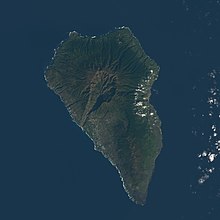La Palma
Las Palmas de Gran Canaria is the capital of the Canary Islands. It is on a different island.
La Palma (Spanish pronunciation: [la ˈpalma]), also San Miguel de La Palma, is the most north-westerly island of the Canary Islands, Spain. La Palma has an area of 708 square kilometres (273 sq mi) making it the fifth largest of the seven main Canary Islands. The total population at the start of 2019 was 82,671, of which 15,716 lived in the capital, Santa Cruz de la Palma, and about 20,467 in Los Llanos de Aridane.

La Palma's highest mountain is the Roque de los Muchachos, at 2,423 metres (7,949 ft) above sea level, being second among the peaks of the Canaries only to the peaks of the Teide massif on Tenerife. La Palma is 6,500 metres (21,300 ft) above the ocean floor.[1]
Like all the other islands of the Canary Islands, La Palma was created by volcanoes on the bottom of the sea, and is the most active volcanic island. In 1815, the German geologist Leopold von Buch visited the Canary Islands. He had been visiting Tenerife, where he visited the Las Cañadas caldera, and then later to La Palma, where he visited the Taburiente caldera, that the Spanish word for cauldron or large cooking pot – "caldera" – became a word that geologists use. In the center of the island is the Caldera de Taburiente National Park; one of four national parks in the Canary Islands.
The Cumbre Vieja volcano erupted in 1949, 1971 and 2021.[1][2]
References
change- ↑ 1.0 1.1 "La Palma". Volcano World. Oregon State University. 27 April 2011. Retrieved March 3, 2021.
- ↑ "La Palma island volcano erupts spewing lava, ash and pyroclastic debris, local evacuations begin". The Canary - News, Views & Sunshine. 19 September 2021. Archived from the original on 21 September 2021. Retrieved 19 September 2021.